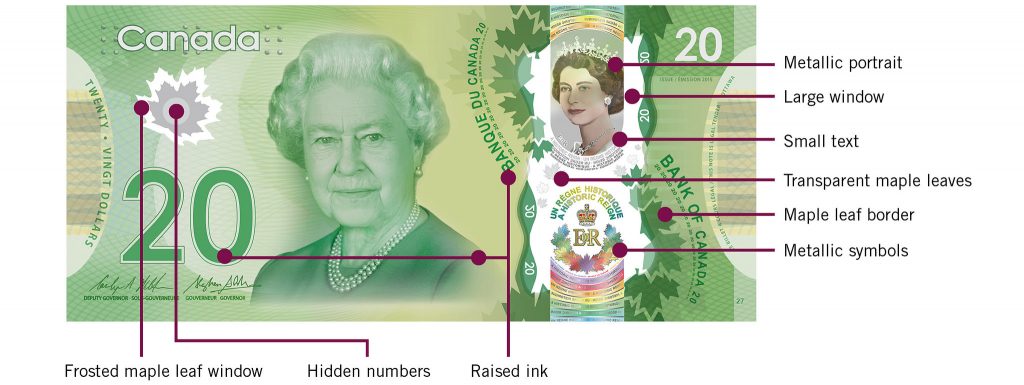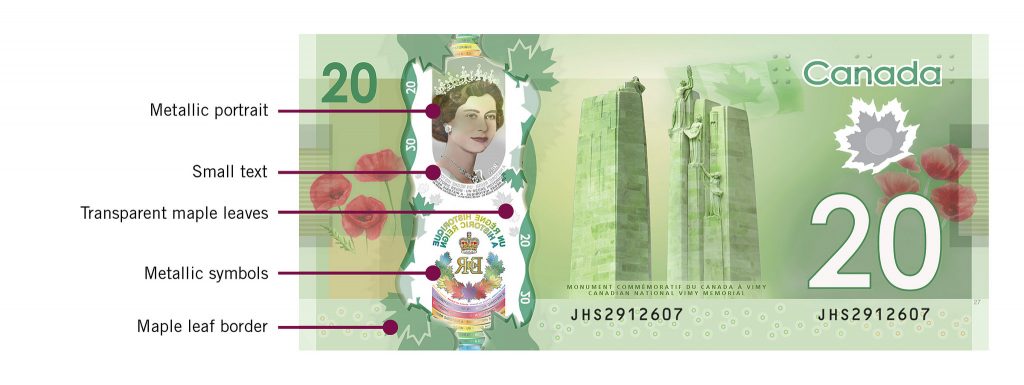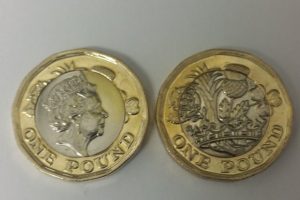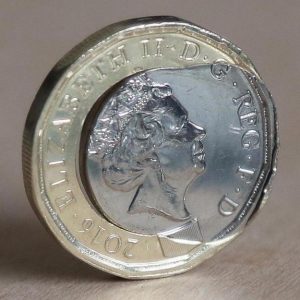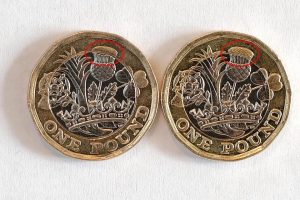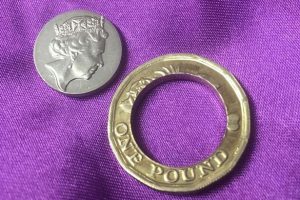It worked… sort of!
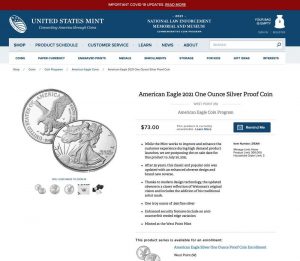 I was able to order the 2021-W American Silver Eagle one-ounce proof coin today with only minor issues.
I was able to order the 2021-W American Silver Eagle one-ounce proof coin today with only minor issues.
Like every other time I ordered new releases from the U.S. Mint, I logged into my account before the sale. I verified that the credit card I had registered was the correct card. The card was in front of me just in case something went wrong.
As the time closed in at noon, I tapped the refresh button. As soon as the button changed from “Remind Me” to “Add to Bag,” I began tapping.
When the page did not respond immediately, I panicked and tapped again. Of course, I should know better. But I am an anxious collector who cares what my background is. After tapping more than once, the coin appeared in my bag, and I pressed checkout.
I did not look at the contents of my bag as I scrolled down to my payment option. I selected my stored credit card then watched as it took too long to fill the form. As it took time, I was pressing buttons faster than the website responded. After the system finally filled in the form, I forgot to enter the CVV for my card. Then another tap.
Once the confirmation page appeared, I took a screenshot of the information for safekeeping. That is when I realized my nervous tapping added more than one coin to my bag. It looks like I ordered three coins. It also may explain an error I received during the tapping on the link when the system thought I was overfilling my bag.
As I type this, the coin sold out. I do not know how long it was before the coin sold out because I had to put down my iPad and go back to work. It looks like if you missed the opportunity to order, then you would have to purchase one on the secondary market.
A quick search on eBay suggests that the presale for graded coins is averaging $135-150.
Stolen Ancient Coins and Art helps fund ISIS
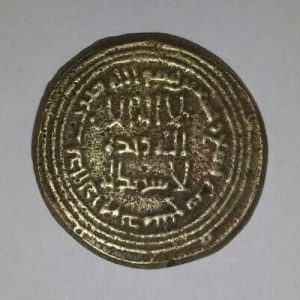
Amateur photos of stolen coins — like this, taken from a cache of images held by a middleman — are sent from phone to phone in the underground trade.
A Wall Street Journal report said that Swiss authorities have been investigating Ali and Hicham Aboutaam, owners of the Phoenix Ancient Art Company with offices in New York and Geneva. It is alleged that items that they have been trading in artifacts looted by ISIS.
In one famous video, ISIS militants were shown destroying artifacts with the voice-over declaring, “These idols and pagans for people in the past centuries were worshiped instead of Allah. When Allah ordered to destroy and remove them, it was an easy matter. We don’t care, even if it costs billions of dollars.”
That may have been a ruse by only showing a few items destroyed since it is estimated that ISIS generates $100-250 million per year selling looted antiquities on the black market.
While art and statues are easy to trace, coins are a different story. Coins can be carried easily in pockets, wrapped in clothes, or just “innocently” thrown into luggage and smuggled anywhere in the world. Detection is difficult and without documentation, they may be difficult to trace.
Reports in the international media note that weak laws and the lure of significant profits have kept the sales of artifacts and looted coins moving through the system. Looted coins have been sold on sites like eBay and Etsy without fear of reprisals because their provenance cannot be proven.
Even though the 1970 UNESCO Convention was agreed upon to stop archaeological pillaging and trafficking of cultural property, the way it is implemented in most countries is to recover the item at its final destination and not in transit. An unsuspecting collector or dealer could be in the position of one of these looted coins but have to face the consequences if they are caught.
The sale of these coins supports ISIS and their terrorist activities. Even after the coins have changed hands several times, they could circulate through the industry and be used by dealers down the like who will continue to trade the coins and using the profits to help fund ISIS.
It would be easy to say to resist buying ancient Syrian or Persian coins, but there are coins that were not stolen and can be legitimately owned. This might be an area that the Ancient Coin Collectors Guild should weigh in on behalf their community.
Until then, try to limit your purchases to reputable dealers and dealers you know.
Wall Street Journal Video
Weekly Numismatic World Newsletter — SERVICE UPDATE
 Since Volume 22 of the “Weekly Numismatic World Newsletter” will not be sent via email, the following would have been the exclusive content included in the newsletter. A service update follows.
Since Volume 22 of the “Weekly Numismatic World Newsletter” will not be sent via email, the following would have been the exclusive content included in the newsletter. A service update follows.
In the collector’s market, scammers are taking advantage of the Royal Mint’s myriad of errors on the new £1 coin and mocking up their own errors to sell online. The error coins are clearly contrived because most either remove the center copper-nickel section or replace it in reverse, showing the Queen’s portrait on the wrong side. A few have been polishing the side with the Queen’s portrait to resemble the 2016 version that was issued by the Royal Mint to businesses for testing.
Canadian authorities have found that altered $5 notes are being used to forge $100 notes. Currently, the $5 note is made of polymer and scammers have found that by cutting out the features in the clear window and taping over the cutouts and still be used. Scammers print their own $100 notes, which are still printed on cotton bond currency paper, and use the clear window to make the notes look legitimate. The problem is that if people looked at the notes, its alterations and counterfeits are easily detectable.
It is interesting that people are so willing to try to figure out how to counterfeit currency, especially when it can be detected if someone put in the time to look. It says a lot about a society when the number one blog post on my site is “How easy is it to pass counterfeit currency” where I discussed the use of the iodine pen and the number one clicked link is the one to the site where I borrowed the image of the of the iodine pen.
The scary part is that people are not paying attention to the simple measures.
SERVICE UPDATE
Unfortunately, the automated system run by MailChimp appeared to have choked on the word “counterfeit.” I am not sure if this is the exact reason for the problem, but their support is so bad that I have not been able to contact a human to explain the issue to me. When I tried to find another provider (SendInBlue based in France), I was accused of being a spammer. Based on what I can find out, MailChimp may have added me to a non-public database blackballing me from finding another service.
If that is the case, then I will likely create a self-hosted newsletter service. Although it is something I am technically capable of doing I was hoping to relieve myself of the management responsibility. Until I can determine my next move, I am suspending the newsletter. Sorry!
Delay for Weekly Numismatic World Newsletter
 To all the readers expecting the Weekly Numismatic World Newsletter, I apologize for the delay. Chalk this up to the list provider over abusing automation and blocking my account.
To all the readers expecting the Weekly Numismatic World Newsletter, I apologize for the delay. Chalk this up to the list provider over abusing automation and blocking my account.
According to the mailing list service, I violated their Terms of Service (TOS). I do not know how I violated the TOS because when I click on their links for the reason, I am sent to their Terms of Service web page. It’s like being punished but not knowing why you are being punished!
The notice I received said that the third-party service that they contract with to check for violators to the TOS is a computer without the smarts of Watson or common sense to understand context. In other words, it was programmed by a bunch of geeks whose knowledge of fuzzy logic defies Boolean logic. I used to work with these types of people… they would drive me crazy!
After some serious word parsing of the TOS, I think it might be because I was talking about counterfeiting. I was not promoting counterfeiting, selling counterfeit items, nor was I providing instruction how to counterfeit, but I was providing a cautionary note with regard to the recent stories about the fake British £1 coin errors and the counterfeited Canadian $100 note.
Unfortunately, the ability to communicate with a sentient being at this company is limited to clicking on a link and sending an email. Since I do not know when they will come to their senses and re-activate my account, I cannot tell you when you will receive the newsletter.
I want to keep the content exclusive to the newsletter. However, if the problem is not resolved by tonight (Monday, June 5), I will post what I wrote here and look for a new provider.
Beware of counterfeit Canadian currency
 Police in Vancouver, British Columbia has discovered that criminals are altering the new polymer notes to create counterfeits that are being passed in the region. The Royal Canadian Mounted Police (RCMP) and the Bank of Canada are warning merchants that criminals are splicing $5 bills to remove the holographic strips and add them to color-copied $100 notes to make them seem less suspicious.
Police in Vancouver, British Columbia has discovered that criminals are altering the new polymer notes to create counterfeits that are being passed in the region. The Royal Canadian Mounted Police (RCMP) and the Bank of Canada are warning merchants that criminals are splicing $5 bills to remove the holographic strips and add them to color-copied $100 notes to make them seem less suspicious.
In order to make sure that the clear window in the polymer notes does not raise suspicion, clear packing tape has been used on the altered $5 notes to cover the alteration.
Discovered in Metro Vancouver, police found that a careful examination of the notes shows that the $5 notes can be altered in a way that does not raise suspicion while creating $100 notes that has been passed with little notice, until recently.
A representative from the Bank of Canada says that criminals are preying on the fact that people are not verifying the notes. The Bank of Canada issued a release urging merchants to check the notes for more than one of the security features.
Travelers to Canada and United States dealers that accept Canadian currency as a convenience to their customers from north of the border should learn about the embedded security features before accepting these notes. Visit the Bank of Canada Banknote website for more information as to how to recognize legitimate currency.
- Anti-counterfeiting features on the front of the Canadian polymer $20 note
- Anti-counterfeiting features on the back of the Canadian polymer $20 note
Beware of fake British pound errors
According to media reports confirmed by the Royal Mint, the three significant errors found are when the thistle on the reverse did not strike properly is produced as a smooth blob, the copper-nickel center of the bimetallic planchet appears to have melted across the coin, and the inner disc and outer ring did not fuse properly. Coins with legitimate errors have been sold on eBay (U.K. and U.S.) for significant premiums.
Unfortunately, scammers have picked up on these problems and have been selling altered coins on eBay as errors. Common alterations are based on removing the silver-colored center and create error-like coins by making different alterations. Amongst the tries to create something that looks like an error includes the Queen’s portrait appearing on the wrong side of the coin and facing the wrong direction which is impossible because of the how these coins are struck, the center of the obverse lacking the Queen’s portrait, and gouges removed from the center.
Both the errors and fakes are being sold for an average of £300 (approx. $386.13) on eBay.
If you want to purchase a British £1 error coin carefully examine the image and the image of a legitimate coin from the Royal Mint’s website. Make sure the person you are buying from has a return policy or buy from a dealer. Of course, it is easier to be careful buying from the U.K. on that side of the Atlantic, but for those U.S.-based error enthusiasts, you have to do your due diligence. Otherwise, you may get stuck with a fake!
Known legitimate errors
- Too hard of a strike is likely to have caused the copper-nickel center to melt across the coin.
- First new £1 coin error found with missing detail on the thistle
- A weak strike can prevent the two metals from fusing properly allowing them to separate
